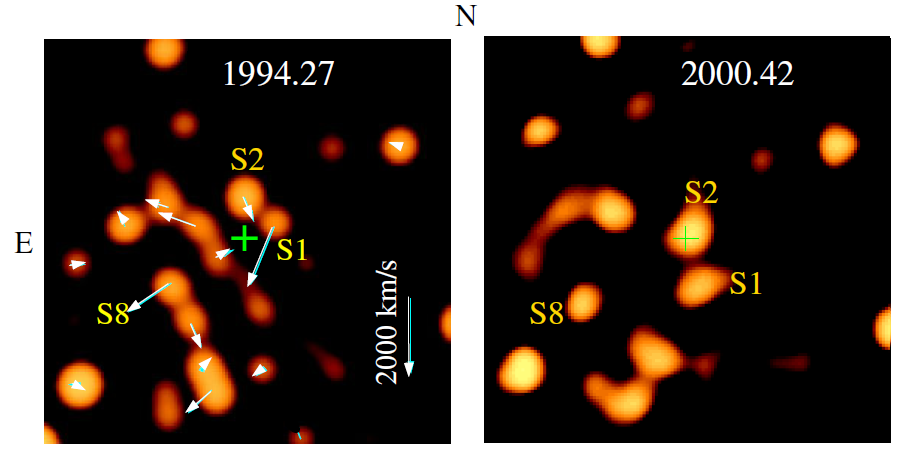


 الفيزياء الكلاسيكية
الفيزياء الكلاسيكية
 الكهربائية والمغناطيسية
الكهربائية والمغناطيسية
 علم البصريات
علم البصريات
 الفيزياء الحديثة
الفيزياء الحديثة
 النظرية النسبية
النظرية النسبية
 الفيزياء النووية
الفيزياء النووية
 فيزياء الحالة الصلبة
فيزياء الحالة الصلبة
 الليزر
الليزر
 علم الفلك
علم الفلك
 المجموعة الشمسية
المجموعة الشمسية
 الطاقة البديلة
الطاقة البديلة
 الفيزياء والعلوم الأخرى
الفيزياء والعلوم الأخرى
 مواضيع عامة في الفيزياء
مواضيع عامة في الفيزياء|
Read More
Date: 13-12-2015
Date: 23-12-2015
Date: 2-2-2017
|
Imaging and proper motions
Over the past 10 years or so we have been conducting a programme to study the properties of the central nuclear stellar cluster via NIR high spatial resolution

Figure 1.1. A comparison of two diffraction limited images taken at different epochs 1994.27 and 2000.42 using the MPE SHARP camera at the ESO NTT. The cross marks the position of the radio source Sgr A∗. The arrows indicate the velocities of stars in the central 1.5'' ×1.5''. Sources S1, S2, and S8 are labeled.
measurements using the MPE (Max-Planck-Institut fur extraterrestrische Physik) speckle camera SHARP at the 3.5 m New Technology Telescope (NTT) of the European Southern Observatory (ESO). This program has resulted in the very first detection of the proper motions of stars that correspond to velocities of up to 1400 km s−1 in the central arcsecond in the vicinity of Sgr A∗ (Eckart and Genzel 1996, 1997). These results have been confirmed by Ghez et al (1998). On the 1.5–3σ level we have now detected (Eckart et al 2001, 2002) orbital curvatures which confirm the recent results by Ghez et al (2000).
In figure 1.1 we show the stars in the central 2'' for two representative epochs: 1994.27 and 2000.42. The position of the compact radio source Sgr A∗ is indicated by a central cross. In the image on the left hand side the velocities are shown as vectors with their end points at the position of the corresponding stars at the later epoch. A comparison of both images clearly shows that the density of sources especially in the central arcsecond is high enough that at the currently reached point source sensitivity (mostly limited by the wings of bright neighboring stars) this region needs to be monitored at least once per year. Such a dense monitoring allows us to identify and track the sources without any doubt. For the fastest star S1 the angular velocity of almost 40 mas yr−1 corresponds to a linear velocity of 1400 km s−1.
The analysis of our best images over the past 10 years has resulted in the detection of the proper motions of stars within the central arcsecond. These motions translate into a one-dimensional velocity dispersion of the stars in the central arcsecond (corrected for the measurement error) of the order of >400 km s−1 (within a radius of ∼0.5''). Of the 2×104 proper motions in Genzel et al (2000), 48 (23%) are determined to 4σ or better. Five proper motions are determined at the ∼10σ level. Of the 227 line-of-sight velocities, 38 (17%) are determined to 4σ or better. For at least 14 (of 29) He I emission-line stars and for 18 late type stars we now have determinations of all three velocity components. With the exception of small amounts of anisotropy (Genzel et al 2000; which are taken into account in Jeans modeling; see later) between 0.035 and 0.35 pc from the compact radio source Sgr A∗ the projected proper motion velocity dispersion per coordinate is in excellent agreement with the radial velocity dispersion results.
Overall the stellar motions do not deviate strongly from isotropy and are consistent with a spherical isothermal stellar cluster. However, a small deviation from isotropy is found for the sky projected velocity components of the young, early type stars. Most of the bright He I emission line stars are on apparently tangential orbits. This overall rotation could be a remnant of the original angular momentum pattern in the interstellar cloud from which these stars were formed. The fainter, fast moving stars within ∼1'' from Sgr A* (the ‘Sgr A* cluster’) appear to be moving largely on radial orbits. Speckle spectroscopy with SHARP at the NTT (Genzel et al 1997) and slit spectroscopy with ISAAC at the VLT suggest that several of them are early-type stars. This is consistent with the idea that these stars are members of the early type cluster with small angular momentum and therefore fell into the immediate vicinity of Sgr A* (Genzel et al 2000, Gerhard 2000).



|
|
|
|
علامات بسيطة في جسدك قد تنذر بمرض "قاتل"
|
|
|
|
|
|
|
أول صور ثلاثية الأبعاد للغدة الزعترية البشرية
|
|
|
|
|
|
|
مكتبة أمّ البنين النسويّة تصدر العدد 212 من مجلّة رياض الزهراء (عليها السلام)
|
|
|